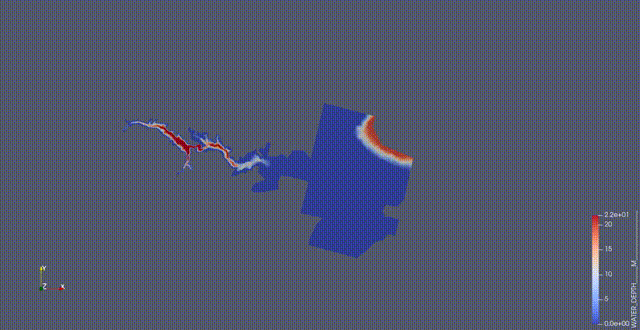Run more simulations. Spend less time configuring.
Run Your First Simulation
This tutorial will show you how to run TELEMAC-2D simulations using the Inductiva API.
We will cover the Malpasset Dam Break use case from the OpenTelemac GitLab repository to help you get started with simulations. This setup models the flood wave resulting from the dam failure, propagating through a valley with realistic topography and open-channel hydraulics using TELEMAC-2D.
Prerequisites
Download the required files here and place them in a folder called opentelemac-input-example.
The folder should include the following:
t2d_malpasset-fine.cas- Mesh and geometry files, such as
geo_malpasset.slf, etc. - (Optional) Boundary condition and results configuration files
Then, you’ll be ready to send your simulation to the Cloud.
Running an OpenTelemac Simulation
Here is the code required to run an OpenTelemac simulation using the Inductiva API:
"""OpenTelemac example."""
import inductiva
# Allocate cloud machine on Google Cloud Platform
cloud_machine = inductiva.resources.MachineGroup(
provider="GCP",
machine_type="c2d-highcpu-32",
spot=True)
# Initialize the Simulator
telemac2d = inductiva.simulators.OpenTelemac( \
version="8p4r0")
# List of commands to run
commands = [
"telemac2d.py t2d_malpasset-fine.cas --ncsize=32", # Run the simulation using 32 cores
"converter.py srf2vtk r2d_malpasset-fine.slf t2d_malpasset.vtk", # Convert the results to VTK format
]
# Run simulation
task = telemac2d.run(
input_dir="/Path/to/opentelemac-input-example",
commands=commands,
on=cloud_machine)
# Wait for the simulation to finish and download the results
task.wait()
cloud_machine.terminate()
task.download_outputs()
task.print_summary()
In this basic example, we're using a cloud machine (c2d-highcpu-32) equipped with 32 virtual CPUs.
For larger or more compute-intensive simulations, consider adjusting the machine_type parameter to select
a machine with more virtual CPUs and increased memory capacity. You can explore the full range of available machines here.
Note: Setting
spot=Trueenables the use of spot machines, which are available at substantial discounts. However, your simulation may be interrupted if the cloud provider reclaims the machine.
Adapting the Script
To adapt this script for other OpenTelemac simulations, replace input_dir with the path to your OpenTelemac
input files and set the the commands accordingly. Be sure to specify the OpenTelemac version compatible with
your input files.
Since this example is a 2D simulation, we use the telemac2d.py command-line script, which is specifically designed for TELEMAC-2D models. It acts as the solver's frontend, reading the .cas steering file and managing the simulation execution.
telemac2d.py t2d_malpasset-fine.cas --ncsize=32
t2d_malpasset-fine.casis the steering file that contains all the settings for the simulation.--ncsize=32tells TELEMAC to run the simulation in parallel using 32 cores. Specifies that TELEMAC should run the simulation in parallel using 32 cores. This value should match the number of vCPUs allocated to your machine.
⚠️ Important: If you don't include
--ncsize, TELEMAC will default to single-core execution, which can significantly slow down large simulations.
The converter.py command converts the result file from Serafin format (.slf) to VTK format (.vtk) so that it can be opened in tools such as ParaView to visualize depth, velocity, and flood propagation over time. An example of the resulting visualization is shown below.

Simulation Completion
When the simulation is complete, we terminate the machine, download the results and print a summary of the simulation as shown below.
Task status: Success
Timeline:
Waiting for Input at 29/04, 12:10:39 1.221 s
In Queue at 29/04, 12:10:41 60.382 s
Preparing to Compute at 29/04, 12:11:41 2.786 s
In Progress at 29/04, 12:11:44 187.482 s
├> 177.258 s telemac2d.py t2d_malpasset-fine.cas --ncsize=32
└> 10.063 s converter.py srf2vtk r2d_malpasset-fine.slf t2d_malpasset.vtk
Finalizing at 29/04, 12:14:51 3.982 s
Success at 29/04, 12:14:55
Data:
Size of zipped output: 104.14 MB
Size of unzipped output: 378.01 MB
Number of output files: 28
Total estimated cost (US$): 0.021 US$
Estimated computation cost (US$): 0.011 US$
Task orchestration fee (US$): 0.010 US$
Note: A per-run orchestration fee (0.010 US$) applies to tasks run from 01 Dec 2025, in addition to the computation costs.
Learn more about costs at: https://inductiva.ai/guides/how-it-works/basics/how-much-does-it-cost
As you can see in the "In Progress" line, the part of the timeline that represents the actual execution of the simulation, the core computation time of this simulation was approximately 187.5 seconds (3 minutes and 8 seconds).